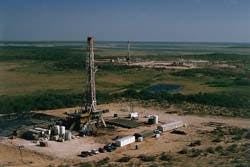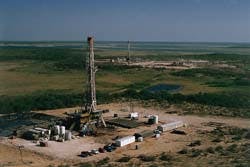TransTexas hikes gas flow in South Texas
A.D. Koen
Senior Editor-News
Southwest Texas Drilling Service's Rig 33 drills TransTexas' 6 Palmyra in the northwest extension area of Bob West North field. Southwest's Rig 36 is working in the center background. Southwest Texas Drilling is a wholly owned unit of TransTexas.
TransTexas Gas Corp., Houston, is rapidly boosting gas production and building reserves with a string of discoveries in South Texas.
The company during the fiscal year ending July 30, 1995, reported net reserves of 1.141 tcf of gas equivalent (tcfe), up from 729 bcf of gas equivalent (bcfe) a year earlier. Of the 412 bcfe gain, new fields in South Texas contributed 367 bcfe.
The rest of the increase came from reserves added in the company's longtime Lobo trend development program in Webb and Zapata counties, Tex. TransTexas considers the Lobo trend the backbone of its South Texas operations.
Among the most promising targets in the company's South Texas drilling program are extensions of Bob West North field in Zapata County, near the Mexican border. Also in South Texas, TransTexas is advancing exploration and development programs in La Grulla field in Starr County and Cuba Libre field in Webb County.
After starting production in late March on a 2,500 acre northwest extension of Bob West North, TransTexas by early June was producing more than 135 MMcfd of gas from its first three wells in the area. Volume breakout was about 40 MMcfd from the 1 Alvarez Gas Unit discovery well, 59 MMcfd from B-1 Palmyra, and 36 MMcfd from 5 Palmyra. All the wells penetrate a previously untested fault block northwest of Bob West North's previous boundary.
"So far, we're not seeing pressure drops," Brent Mejia, TransTexas exploration manager, said of the three Bob West North northwest extension wells. "With the flow rates we're getting, it appears the extension could be bigger than we first thought."
In addition, TransTexas in early June was completing 1 Palmyra Ltd., the first well on a separate structure within a 1,206 acre area on the eastern flank of Bob West North. The well cut 52 ft of net pay at an undisclosed depth.
In La Grulla field, meantime, TransTexas' 1 Olivares appraisal well confirmed the presence of hydrocarbons in the same sands found productive in the field's 1 Garcia Heirs discovery well.
Gathering momentum
Net reserves added by TransTexas in 1995 included about 118 bcfe in Bob West North, 98 bcfe in La Grulla, and 151 bcfe in Cuba Libre.
In the most recent independent estimate, the company's net reserves as of Feb. 1, 1996, amounted to slightly more than 1.156 tcfe. TransTexas since July 1995 had added about 15 bcfe of reserves while producing about 65 bcf.
TransTexas Pres. Arnold Brackenridge estimated Bob West North's northwest and east extensions could add another 120-270 bcfe to the play.
Mejia said TransTexas in the next 2-3 years could drill as many as 17-20 wells in the extension areas of Bob West North but only a handful in Bob West North field proper. The company expects to complete six to eight wells this year in the area.
Mejia said the first three Bob West North northwest extension wells have been unusual. After fracturing, they take longer than wells in the main field to clear completion fluids and downhole debris. "But when they do, their production just keeps increasing," he said.
For example, 1 Alvarez in early spring flowed a combined 23.5 MMcfd of gas from 172 ft of net pay in Eocene Lopeno and Perdido sands above 13,045 ft at a bottomhole location under Falcon Reservoir on the U.S.-Mexican border. The well's surface location was 1.2 miles northwest of Bob West North field.
Similarly, B-1 Palmyra flowed a combined 20.7 MMcfd from 156 ft of net Lopeno pay, and 5 Palmyra a combined 24.3 MMcfd from 134 ft of net pay in Lopeno sands at 8,570-8,930 ft. Production from the latter well in early June still was increasing.
"Flow rates from wells in the northwest fault block indicate higher permeability than other areas of the lower Wilcox formation and are providing drilling cost payback in less than 2 months," Brackenridge said.
Porosities in the upthrown intervals productive in Bob West North's northwest extension range as high as 24%. In Bob West North field proper, TransTexas wells have porosities ranging from 18% to 21%.
Background
Several producers have been working since the late 1980s in the Bob West field of Starr and Zapata counties.
Texas Railroad Commission data show Bob West production earlier this year amounted to slightly more than 310 MMcfd from more than 90 wells. Industry estimates of Bob West reserves range as high as 700 bcfe in Eocene upper Wilcox at 8,700-14,000 ft.
TransTexas in 1994 began exploring a 15,000 acre area north of the fault line marking the northern boundary of Bob West field. The company believed drilling in the area had missed large gas bearing structures at relatively shallow depths north of the fault.
Exploration at first was hampered by landowners' insistence that an earlier, noncommercial well north of Bob West field be completed as a producer.
Despite the delay, TransTexas in December 1994 logged 34 ft of net pay in two zones above 13,600 ft total depth in its first exploratory well north of Bob West. The 2 Perez discovery well flowed a combined 10 MMcfd through a 24/64 in. choke.
That success prompted TransTexas to kick off a leasing program in which it spent about $13.3 million acquiring 100% interests in more than 15,000 acres in the Bob West North area.
The company throughout 1995 maintained a five rig drilling program on the acreage. In early June, TransTexas was producing about 150 MMcfd from about 20 wells in Bob West North and the field's northwest extension.
The higher flowing pressures of the company's three wells in the field's northwest extension were impeding flows of wells in Bob West North proper.
In addition, TransTexas was drilling two more wells, 2 Alvarez and 6 Palmyra, in the northwest extension area, both of which it expected to complete by the end of July.
Company officials hope to boost Bob West North production to as much as 250 MMcfd. Ultimate recovery of gas wells could amount to as much as 400-500 bcfe.
La Grulla, Cuba Libre
TransTexas also in South Texas is drilling programs in La Grulla and Cuba Libre fields, where gross production in early June amounted to slightly less than 20 MMcfd and about 10 MMcfd, respectively.
In La Grulla, the company on June 12 said 1 Olivares cut 42 ft of Eocene Queen City net pay at 8,680-9,100 ft in an upthrown fault block.
The well is 2.8 miles northwest of La Grulla's 1 Garcia Heirs discovery well.
TransTexas estimated the cost of drilling and completing 1 Olivares at about $700,000.
Also in La Grulla in mid-June, TransTexas had drilled past 11,300 ft in 1 Lovejoy, programmed to test a downthrown fault block from a location about 1/2 mile east of 1 Garcia Heirs.
TransTexas in December 1995 began production from 1 Garcia Heirs, the La Grulla discovery well. The well in October 1995 flowed 30.5 MMcfd through a 30/64 in. choke with 7,810 psi flowing tubing pressure from Queen City intervals at 11,300-11,400 ft.
TransTexas transports gas from La Grulla through a 20 in. pipeline lateral in Starr County. Gas flows from the lateral through Valero's South Texas gas pipeline system and into the main TransTexas gas pipeline system for delivery to the company's Agua Dulce marketing hub.
TransTexas last January finished construction of a 100 MMcfd amine treatment plant on the La Grulla lateral.
Last December, TransTexas began producing 3.9 MMcfd of gas and 35 b/d of condensate from 1 A. Laurel, discovery well for Cuba Libre field. The flow was through a 12/64 in. choke with 6,024 psi flowing tubing pressure from two lower Wilcox sands at undisclosed depths.
TransTexas a year earlier logged 155 ft of upper and lower Wilcox net pay in the discovery well. Officials chose to delay completing the well in favor of a leasing program that netted 40,000 acres in the area.
The company in mid-December 1995 said its 2 A. Laurel appraisal well, about 3,400 ft northeast of 1 A. Laurel, cut 118 ft of net pay in six zones. The well penetrated productive upper, middle, and lower Wilcox intervals, confirming Cuba Libre's potential in the deepest formation.
Cuba Libre production comes from four older wells and five TransTexas wells, the latter producing from the Hinnant formation, an upper Wilcox zone at 7,500-11,000 ft.
TransTexas in early June had suspended Cuba Libre drilling to await data from a 47 sq mile 3D seismic survey. The company finished collecting field data about yearend 1995.
TransTexas in mid-June reported net gas production in Texas of 465 MMcfd on gross output of 650 MMcfd.
The net gas volume was third highest among gas producers in the state.
Copyright 1996 Oil & Gas Journal. All Rights Reserved.

